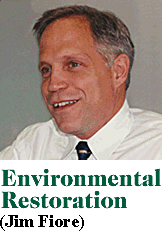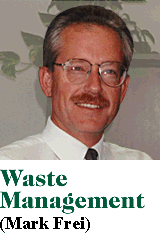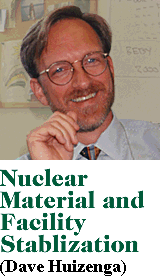

 |
EM-40's Jim Fiore began by telling Initiatives that "we [the Environmental Restoration program] have acceptable technical solutions for all our problems and (except for DNAPLs*) have had them for years." So it seemed paradoxical for him to follow this assertion by reiterating a statement he made in the spring of 1997 when the value of the technology program was being questioned by some on the Hill: "If the technology program gets zeroed out and goes down the tubes, then EM in general and restoration in particular will be unsuccessful." What's the story? |
| The story comes at the end of Fiore's
explanation of his program's priorities—managing
projects well; working with regulators to focus on the
common goal of actual cleanup, not just process; moving
forward quickly on high-risk site cleanups; and finding
new, creative, "out-of-the-box" ways to do
business—all of which add up to the goal to
"do real work in the field, get sites done, and get
out of business." "Bringing new technologies into restoration," Fiore's final priority, is key to accomplishing the ER program's goal, and therefore the goal of the EM program itself, because of the need, and now the commitment, to achieve closure faster and cheaper. As Fiore says, "everyone wins when cleanup is done faster." The ER program scope—remediating about 5,700 contaminated ground-water plumes and decommissioning 700 facilities—represents the bulk of the EM cleanup mortgage, and Congress simply won't pay, because it knows it shouldn't have to, for the application of slow, inefficient technology. Air strippers for treating ground water have been around for a long time, but they're expensive. Today, recirculating wells employing in situ air strippers do the job at half the cost. (Note the FY 1998 ASTD project, In-Well Air Stripping Technology to Remediate an Off-Site Organic Plume, at Brookhaven National Laboratory. And the passive GeoSiphon system, where it can be applied, is twice again as cost-effective.) Fiore uses the charts below to portray his main point: "In Situ Remediation Technologies: Driving Down Cleanup Costs and Schedules." Four additional FY 1998 ASTD projects respond precisely to this point: they include a Permeable Reactive Treatment Wall for Radionuclides and Metals at Albuquerque; Contaminated Soil Cleanup Using the ACT*DE*CON Process at Mound, in Ohio; the Segmented Gate System combined with Integrated Soil Processing at Mound and Idaho, which drastically reduce the volume of soil to be treated; and an Integrated Technology Suite for Cost-Effectively Delineating Contamination in Support of Soil Remediation Actions for decision support at Fernald. Fiore is proud of EM's new technological capability and of the collaboration of headquarters and field people in demonstrating to Congress and regulators EM's ability to do more and do it better, in less time and with less money. Another OST-funded activity that benefits the restoration is the "Inspector 12" role played by Florida International University's Hemispheric Center for Environmental Technology, which conducts "consumer reports" analyses on vendor technologies. "It's an excellent source of information," says Fiore, "used by Fernald and other sites." In addition to enhancing cleanup, says Fiore, the other benefits of new technology are in the area of characterization. The cone penetrometer, for example, "lets us put down boreholes faster and cheaper, and new instrumentation allows real-time characterization and continuous monitoring." All in all, says Fiore, "things are dramatically improved in the last two years. OST is refocusing on meeting users' needs. They're not there yet, but they're getting there. It's like turning the Queen Mary—it takes a while to begin turning; but once the shift starts, the momentum is great." And EM-40 management and staff are helping in this effort. "Our folks sit in on focus area meetings. We must help Gerald [Boyd] to focus the program, then together convince the Hill that it's focused, that it's worth the value." But Fiore clarifies that better technology alone can't be the whole answer. Pervasive, continual challenges confront the EM program, including the need to maintain the right balance between a site focus and a national program perspective; the reality of legal challenges; the need to "think of ourselves more as a business, differentiating ourselves from competitors as outstanding, best-in-class, in order to win the battle in Congress where hundreds of programs fight for limited dollars; the challenge of maintaining positive relationships with stakeholders while budgets are flat or declining; and finally, the challenge posed by data overload." The Internet, says Fiore, gives end users huge amounts of data on potential solutions, but somebody needs to serve project managers by making these data into useful, friendly information. "It should be happening in Site Technology Coordination Groups. OST could take leadership in making this happen better."
*The DNAPL exception is an exceptional story in itself. Less than 10 years ago, top ground-water people predicted that breakthroughs in locating and remediating DNAPL source terms and plumes were probably at least 20 years off and that certain contaminated aquifers would simply have to be considered to have "terminal cancer" and abandoned. Today, largely due to technologies that came out of projects in OST's Subsurface Contaminants Focus Area—among them LASAGNATM, Six-Phase Soil Heating, Geo-CleanseŽ, and In-Well Vapor Stripping—not only are those pessimistic predictions proved incorrect, but the very people who made them are busily trying to patent solutions! |
|
| Click on each of the (acting) deputy assistant secretaries below to see how OST rates with its customers. |
 |
 |